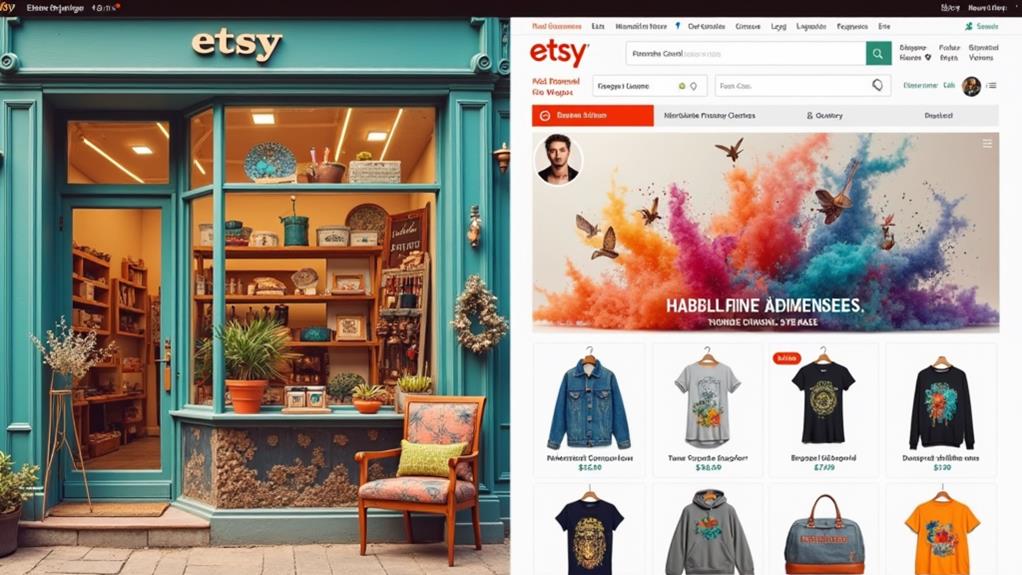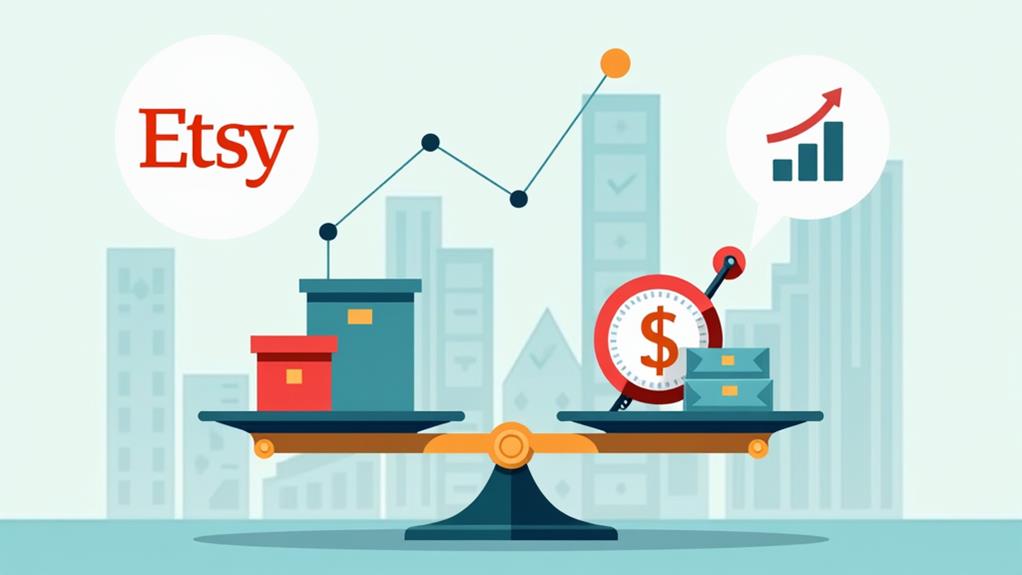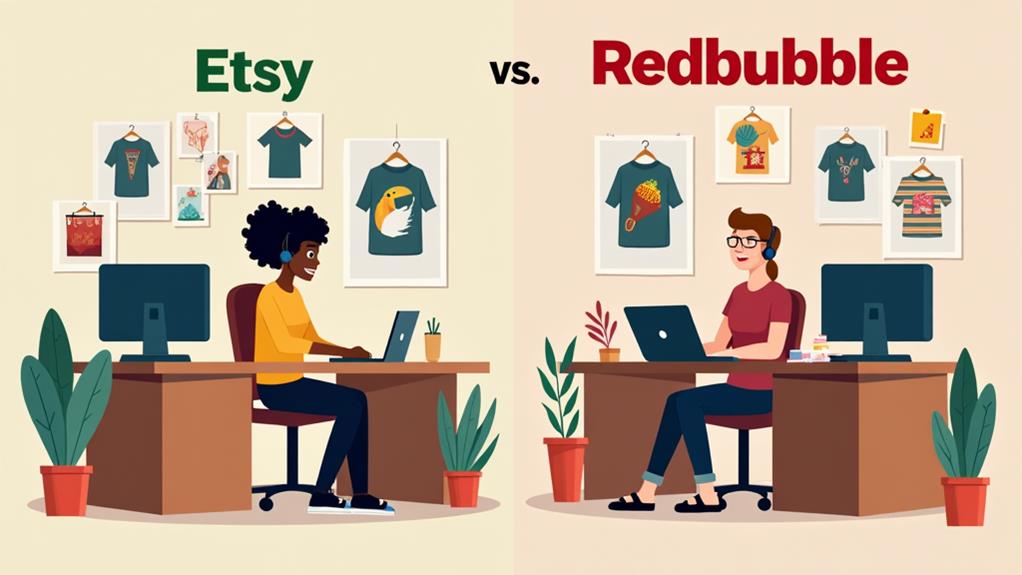
Etsy tends to be more profitable for sellers who can manage production costs, set competitive prices, and leverage effective marketing, with the potential to retain up to 90% of the sale price after fees. In contrast, Redbubble offers a lower hassle setup with no listing fees but typically allows artists to keep only 15%-20% of the sale price based on the markup. Etsy's vast audience and customizable storefront options help build brand identity, while Redbubble appeals to a niche market with younger demographics. Further analysis of setup complexity, audience reach, and cost structures can reveal deeper insights.
Key Takeaways
- Etsy sellers can retain up to 90% of the sale price, offering higher profit margins than Redbubble.
- Redbubble artists typically keep 15%-20% of sales based on chosen markup, which is lower compared to Etsy.
- Etsy's extensive setup and listing fees result in higher costs but also higher earnings potential per sale.
- Redbubble's lack of listing and transaction fees reduces upfront costs, but higher base prices limit profit margins.
- Etsy's customizable storefronts and extensive promotional tools can enhance seller visibility and profitability.
Marketplace Overview
When comparing Etsy and Redbubble, a thorough marketplace overview reveals significant differences in their operational models and audience reach. Established in 2005, Etsy primarily serves as a marketplace for handmade and vintage items, connecting 96.3 million buyers with 7.5 million sellers, and hosting approximately 120 million individual products.
In contrast, Redbubble, founded in 2006, is a print-on-demand platform where artists upload designs for over 80 products, generating sales from around 4 million customers annually.
Analyzing market trends, Etsy's broader audience reach is evident with over 503.3 million monthly visits, compared to Redbubble's 23.7 million. User feedback highlights Etsy's appeal to a diverse customer base seeking unique, personalized items, while Redbubble attracts customers looking for customizable products with a wide range of artistic designs.
It's worth noting that platforms like Shopify and Etsy also simplify online store launches, making it easier for sellers to tap into niche markets.
Operationally, Redbubble operates on a royalty model, allowing artists to set profit margins above base prices. Etsy, however, charges listing fees and takes a percentage of sales, impacting overall profitability.
Additionally, Redbubble handles production and shipping, reducing logistical burdens for artists, whereas Etsy sellers manage their own fulfillment, offering potential for higher profits but requiring more effort and responsibility.
Setup and Usability
When comparing setup simplicity, Redbubble offers a more streamlined process with immediate design uploads post-registration, while Etsy's setup involves creating a storefront and detailed product listings.
Additionally, Redbubble's ease of use reflects its focus on flexibility and adaptability, enabling quick responses to market trends and customer preferences.
Regarding customization, Etsy provides extensive opportunities for sellers to establish a unique shop identity with personalized branding elements, whereas Redbubble limits customization to basic artist profiles.
These differences highlight the contrasting approaches of each platform in balancing ease of entry with personalization capabilities.
Setup Simplicity
Setting up a shop on Redbubble and Etsy presents distinct levels of complexity and usability for sellers. Redbubble offers a straightforward sign-up process that allows artists to start uploading designs immediately, requiring only basic information like email and payment details. This streamlined approach greatly enhances the user experience, making it more accessible for newcomers to the print-on-demand space.
In contrast, Etsy's setup involves a more complex process. Sellers must create a storefront and detailed product listings, which may take longer to complete. This complexity can be intimidating, particularly for first-time sellers. The necessity for detailed input on each product adds to the initial setup time, impacting the overall user experience.
Key differences in setup simplicity include:
- Redbubble's simplified design upload process versus Etsy's detailed product listings.
- Basic information required by Redbubble compared to Etsy's storefront creation.
- Etsy's initial product listing requirement during account creation.
- User-friendly interface of Redbubble enhancing accessibility.
- Potential overwhelm for first-time sellers on Etsy due to its detailed setup requirements.
Both platforms allow sellers to choose their store name, but Redbubble's user-friendly interface and minimal setup requirements offer a more simplified and efficient sign-up process.
Customization Options
Delving into customization options, Etsy offers a more robust framework for sellers who wish to personalize their storefronts extensively. Sellers on Etsy benefit from extensive customization options, including shop icons, banners, and an "About Us" section, which collectively enhance the branding impact.
This degree of design flexibility allows sellers to create a distinctive brand identity, potentially leading to higher customer retention and sales.
On the other hand, Redbubble features a simpler setup process, allowing immediate design uploads after registration. However, Redbubble's customization options are limited primarily to artist profiles and product descriptions, which might constrain the branding impact for sellers looking to establish a unique market presence.
This streamlined approach benefits artists who prioritize ease of use and quick setup over extensive design flexibility.
Etsy's platform, while more complex for first-time sellers, includes tools for managing inventory and customer interactions, providing a personalized selling experience.
This allows sellers to set their own prices, offering greater control over profit margins. Conversely, Redbubble sets fixed base prices with artists adding a markup, which simplifies the process but limits profit control.
Product Range
A thorough examination of the product range between Etsy and Redbubble reveals distinct differences that cater to varying seller and buyer needs.
Both platforms offer unique strengths that appeal to different market segments. Redbubble excels in product variety within the print-on-demand space, offering over 80 different items such as apparel, stickers, home decor, and accessories. This extensive range makes it a favored choice for graphic designers and artists who want to showcase their designs across multiple products.
Additionally, Redbubble's consistent quality is managed directly by the platform, ensuring a uniform standard across all items.
Etsy, on the other hand, serves niche markets by specializing in handmade, vintage, and custom-made items. This allows sellers to offer a broader spectrum of unique products beyond the print-on-demand model.
The platform supports a higher degree of customization, enabling sellers to create personalized listings tailored to their brand identity.
- Redbubble:
- Over 80 print-on-demand products
- Focus on graphic designs and artists
- Consistent quality managed by Redbubble
- Etsy:
- Handmade, vintage, and custom items
- Broader product categories including craft supplies
- Quality managed by individual sellers
Customization and Branding
When examining customization and branding opportunities on Etsy and Redbubble, it becomes evident that Etsy provides a more extensive suite of tools for sellers to establish a distinct brand identity.
Etsy allows sellers to create a unique shop identity through customizable storefronts, including shop icons, banners, and personalized "About Us" sections. This level of customization supports brand storytelling, enabling sellers to build customer loyalty and recognition.
Additionally, Etsy sellers can control their pricing and product presentation, which allows for strategic branding that can enhance perceived value and profitability. Consistent messaging on Etsy can boost revenue by up to 23%, highlighting the platform's potential for effective branding.
In contrast, Redbubble offers limited customization options. Artists can set up their profiles and design product variations, but lack the ability to create a distinct brand identity as effectively as on Etsy.
The pricing structure on Redbubble is based on a set base price plus artist markup, limiting sellers' control over strategic branding. Furthermore, Redbubble's emphasis on the print-on-demand model prioritizes design differentiation over brand storytelling, making it harder for artists to stand out in a saturated market.
Traffic and Audience

Etsy commands a significant lead in monthly visits with 503.3 million compared to Redbubble's 23.7 million, creating a larger potential audience for sellers.
However, Etsy's demographic skews towards individuals aged 25-44 with a majority being female, whereas Redbubble's audience is primarily aged 18-34 and more focused on graphic design and artistic products.
While Etsy offers greater opportunities for organic reach due to its traffic volume, it also presents higher competition among over 7 million sellers, necessitating effective promotion strategies to maintain visibility.
Engaging with user-generated content through contests or challenges can be an effective tactic to stand out on Etsy.
Monthly Visits Comparison
Comparing the monthly visits to Etsy and Redbubble reveals significant differences in traffic and audience demographics, highlighting distinct advantages and challenges for sellers. Etsy attracts over 503.3 million monthly visits, making it a dominant player in the print-on-demand market. In contrast, Redbubble receives approximately 23.7 million monthly visits, offering a smaller yet substantial audience for independent artists.
The market trends indicate that:
- Etsy's extensive reach: The larger audience on Etsy may lead to increased sales opportunities, though it also brings heightened competition among over 7 million sellers.
- Redbubble's niche appeal: Redbubble's audience primarily consists of younger consumers, with 57% of visitors aged between 18-34, which can impact the types of products that perform well.
- Audience engagement: Sellers on both platforms must actively promote their products, especially on Redbubble, where organic traffic is lower compared to Etsy's broader reach.
- Sales potential: The broader audience on Etsy may offer more sales opportunities, but Redbubble's smaller, more targeted audience can be advantageous for niche markets.
- Marketplace dynamics: Understanding the traffic and audience demographics is essential for tailoring marketing strategies and product offerings on each platform.
Demographic Target Audience
Understanding the demographic target audience of both Etsy and Redbubble is vital for sellers aiming to optimize their marketing strategies. Etsy attracts approximately 503.3 million monthly visits, a substantial figure compared to Redbubble's 23.7 million monthly visits.
However, the nature of their target audiences differs markedly. Etsy's demographic skews slightly older, with 48% of its users aged 25-44. In contrast, Redbubble primarily appeals to a younger audience, with 57% of its users aged 18-34.
Etsy buyers are often on the lookout for unique, handcrafted items, leading to higher audience engagement among artisans and crafters. This strong community engagement on Etsy fosters collaboration and support, enhancing customer loyalty over time.
On the other hand, Redbubble's customers typically seek artistic designs on various print-on-demand products, which attracts a different type of audience engagement. The platform relies more on artists promoting their work independently, which can influence the level of direct interaction between buyers and sellers.
These demographic insights are vital for sellers in tailoring their marketing efforts, ensuring they align with the distinct preferences and behaviors of their respective marketplaces' target audiences.
Competition and Visibility
With a clear understanding of the distinct demographic target audiences of Etsy and Redbubble, it is important to analyze the competition and visibility that each platform offers.
Etsy attracts a substantial 503.3 million monthly visits, providing a broad potential audience. In contrast, Redbubble sees 23.7 million monthly visits. This disparity highlights Etsy's wider reach but also points to a more crowded marketplace.
With over 7 million sellers on Etsy, the competition is fierce, making it challenging for new sellers to gain visibility. Conversely, Redbubble's niche targeting towards graphic designers allows for more focused promotional strategies, although it still faces market saturation.
Key points include:
- Etsy's larger traffic: 503.3 million monthly visits vs. Redbubble's 23.7 million.
- Seller competition: Over 7 million sellers on Etsy compared to a less saturated Redbubble.
- Demographics: Redbubble's audience is 57% aged 18-34, while Etsy's is broader, with 48% aged 25-44.
- Promotional strategies: Redbubble artists often rely on social media for visibility due to less organic reach.
- Market saturation: Both platforms face challenges, yet Etsy's extensive traffic may offer more sales opportunities.
Fees and Costs
Maneuvering the fees and costs associated with Etsy and Redbubble reveals distinct financial landscapes for sellers on each platform. A thorough cost analysis indicates that Etsy charges a $0.20 listing fee per item, a 6.5% transaction fee, and a payment processing fee of 3% plus $0.25.
This multi-layered fee structure can greatly impact the profit breakdown for sellers. An Etsy seller typically retains approximately $15 from a $100 sale after accounting for these fees. Successful sellers on Etsy often leverage SEO optimization and customer engagement to mitigate the impact of these fees.
Conversely, Redbubble adopts a different approach. Artists can set their own markup, typically between 15%-20% above the base price, with no listing or transaction fees.
However, Redbubble's higher base prices can reduce profit margins, as earnings are derived from the difference between the base price and the artist's chosen markup. For instance, an artist might earn around $6 from a $20 t-shirt sale, depending on the markup.
Profit Margins

When comparing profit margins, Etsy sellers can retain up to 90% of the sale price after fees, contingent on strategic cost management.
In contrast, Redbubble artists typically keep 15%-20% based on their chosen markup. By leveraging effective marketing strategies and optimizing service offerings, Etsy sellers can further enhance their profitability.
Etsy's multiple fees, including listing, transaction, and payment processing fees, necessitate careful pricing control to maximize earnings.
Despite lower upfront costs on Redbubble, the potential for higher earnings on Etsy may attract sellers willing to handle their own production and shipping logistics.
Fee Comparison
Evaluating the fee structures of Etsy and Redbubble reveals distinct differences in how each platform impacts sellers' profit margins. Etsy imposes a $0.20 listing fee per item, in addition to a 6.5% transaction fee and a 3% payment processing fee. These costs can greatly affect profit retention for sellers.
In contrast, Redbubble employs a royalty structure where artists earn a markup, typically between 15% and 20%, above the base price set by the platform, with no listing or transaction fees.
Key points of comparison include:
- Listing fees: Etsy charges $0.20 per item, whereas Redbubble has none.
- Transaction fees: Etsy imposes a 6.5% fee on sales, while Redbubble does not.
- Processing fees: Etsy adds a 3% payment processing fee, impacting earnings further.
- Royalty structure: Redbubble artists earn through markups, usually 15%-20%, leading to variable profit retention.
- Profit retention: Etsy sellers might retain approximately 90% of the sale price after fees; Redbubble artists keep around $6 from a $20 t-shirt sale, reflecting differing earnings breakdowns.
Etsy's pricing flexibility allows sellers to manage markup strategies and profit margins effectively. In contrast, Redbubble's fixed base prices constrain potential earnings, underscoring the importance of understanding both platforms' fee structures for maximum profitability.
Pricing Control
In the domain of pricing control, Etsy affords sellers substantial flexibility, enabling them to set prices based on their individual cost structures and desired profit margins. This control allows Etsy sellers to implement dynamic pricing strategies, thereby optimizing profits by adjusting prices according to market demands and production costs.
Sellers on Etsy can potentially retain up to 90% of the sale price after accounting for listing, transaction, and payment processing fees, which collectively total approximately 9.5% of each sale plus $0.45.
Conversely, Redbubble offers a more streamlined approach where artists can set their profit margins, typically adding 15%-20% on top of the base prices. While Redbubble's lack of listing or transaction fees simplifies the pricing structure, the higher base prices can reduce overall profits per item.
The fixed pricing model on Redbubble limits the ability to adjust for cost variations, potentially impacting profit optimization.
Etsy's model, which includes managing fulfillment and production costs, allows for more nuanced pricing strategies. Sellers can leverage efficient sourcing strategies to enhance profit margins, positioning Etsy as a platform with greater potential for profit optimization compared to Redbubble's fixed pricing constraints.
Each platform's unique approach to pricing control considerably influences the profitability for sellers.
Earnings Potential**
Shifting focus from pricing control, the earnings potential (profit margins) on Etsy and Redbubble exhibits marked differences influenced by each platform's fee structures and pricing strategies.
On Redbubble, artists typically earn a profit margin of 15%-20% by adding a markup to the base prices set by the platform. This approach allows for passive income without upfront costs but limits profit optimization due to fixed base prices.
Conversely, Etsy sellers retain approximately 90% of the sale price after accounting for various fees, including a $0.20 listing fee, a 6.5% transaction fee, and a 3% payment processing fee.
Key considerations include:
- Redbubble's 15%-20% profit margin: Limited by platform-set base prices, providing lower, yet passive, earnings.
- Etsy's 90% retention: Higher potential earnings, contingent on effective management and marketing.
- Example comparison: A $20 t-shirt sale on Redbubble yields about $6, whereas a $100 sale on Etsy retains around $90.05.
- Profit optimization on Etsy: Sellers can set their own prices and manage production costs to maximize profits.
- Market saturation: Both platforms face high competition, but Etsy's larger audience of 503.3 million monthly visits may enhance visibility and sales.
Analyzing these factors, Etsy offers greater potential for higher profit margins through strategic earnings strategies and cost management.
Payment Methods
When analyzing the payment methods offered by Etsy and Redbubble, it is crucial to contemplate the implications on both seller convenience and profitability.
Etsy provides notable payment flexibility through its Etsy Payments system, enabling sellers to accept multiple payment methods such as credit cards, debit cards, PayPal, and Etsy gift cards. Sellers can also choose their payout frequency, ranging from daily, weekly, biweekly, to monthly. This flexibility is particularly beneficial for sellers managing multiple income streams, such as those involved in remote side hustles.
However, the platform charges a 6.5% transaction fee, a 3% payment processing fee, and a $0.20 listing fee per item, which collectively impact the net profitability of each sale.
In contrast, Redbubble operates with a more streamlined payment structure. Artists receive monthly payouts via PayPal or direct deposit, available only for Australian, U.S., and U.K. bank accounts, after reaching a $20 minimum threshold.
This method guarantees consistent cash flow but lacks the payment flexibility seen with Etsy. Redbubble does not impose listing or transaction fees, allowing artists to retain more of their earnings, which can be advantageous given that artists can set their profit margins through markups.
Seller Support

Seller support is a critical aspect of the overall experience for individuals utilizing print-on-demand platforms like Etsy and Redbubble. Analyzing the support structures of these two marketplaces reveals significant differences that can impact seller collaboration and customer relationships.
Etsy offers robust support, available 24/7, and extensive resources:
- 24/7 support and thorough seller resources: Forums and community features encourage collaboration among sellers.
- Direct communication with buyers: Facilitates the building of strong customer relationships, potentially increasing satisfaction and sales.
- Significant seller community: Over 7 million sellers contribute to a vibrant, supportive environment. Additionally, Etsy emphasizes handcrafted items, ensuring a unique marketplace for creative sellers.
- Personalized problem resolution: Quicker and tailored responses to issues, enhancing the seller experience.
- Community-driven assistance: Sellers can share experiences and tips, fostering a collaborative atmosphere.
In contrast, Redbubble's support mechanisms are more limited:
- Email-based support: Often results in slower response times and less personalized assistance.
- Centralized customer service: Redbubble handles customer service and returns, allowing sellers to focus on creation but limiting direct customer interaction.
- Isolated seller environment: Less community engagement compared to Etsy, affecting potential for seller collaboration.
Alternatives to Consider
Exploring alternatives to Etsy and Redbubble can provide sellers with a wider array of options tailored to different needs and niches. One significant alternative is Society6, which offers high-quality art prints and merchandise with a more curated selection. The platform also provides higher artist commission rates on certain products, making it an attractive option for artists seeking better financial returns.
Understanding market rates can help in evaluating commission structures across different platforms.
Teespring (now Spring) stands out for its flexibility, enabling creators to design and sell custom products through social media integrations and various e-commerce tools. This flexibility in branding and fulfillment allows sellers to reach diverse audiences more effectively.
Zazzle is another strong contender, known for its extensive customization options. Sellers can create and sell a wide range of products, from home goods to stationery, while earning a royalty percentage based on sales. This level of customization can attract a broad customer base looking for unique, personalized items.
For photographers and visual artists, Fine Art America offers print-on-demand services along with art licensing and a dedicated art community.
Meanwhile, ArtStation caters to digital artists and illustrators, providing a platform for selling prints, merchandise, and digital products while fostering a supportive community and networking opportunities.
Frequently Asked Questions
Is Etsy or Redbubble Better to Sell On?
Etsy may be better for sellers focused on branding and customer engagement despite higher Etsy fees. Redbubble, with its royalty model and broader audience, suits those preferring low-effort sales. Marketing strategies and product variety are essential considerations.
Which Print-On-Demand Service Is Most Profitable?
To determine the most profitable print-on-demand service, analyzing market trends and pricing strategies is essential. Profitability hinges on control over pricing, fee structures, and marketing effectiveness, with differing advantages based on the seller's operational model.
What Is the Best Marketplace to Sell Prints On?
The best marketplace to sell prints depends on your target audience and marketing strategies. Etsy offers greater organic reach for unique items, while Redbubble's royalty model is ideal for low-effort profit. Analyze each platform's audience and fee structure.
Is Selling Print-On-Demand on Etsy Profitable?
Yes, selling print-on-demand on Etsy can be profitable. Etsy seller strategies, such as optimizing print on demand pricing and managing fulfillment costs, can result in retaining approximately 90% of the sale price, enhancing profitability.
Conclusion
The comparative analysis of Etsy and Redbubble reveals distinct advantages and disadvantages pertinent to each platform. Etsy excels in customization, branding, and a diverse product range, while Redbubble offers ease of setup and a broad audience reach. Profit margins, traffic, and seller support vary, influencing overall profitability. Ultimately, the choice between Etsy and Redbubble should be informed by specific business needs, target audience, and strategic goals, as both platforms provide unique opportunities within the print-on-demand marketplace.
Leave a Reply